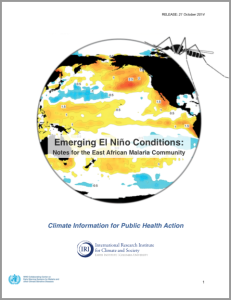El Niño and Global Health: Latest Bulletin
The Public Health group at the International Research Institute for Climate and Society has posted a new update of its bulletin on El Niño, focused on providing information to assist health planners and practitioners concerned with malaria in Eastern Africa. Emerging El Niño Conditions: Notes for the East African Malaria Community, takes into account IRI’s latest forecasts.
As with previous bulletins, IRI lists several recommendations for improving risk management and disease surveillance in the face of changing climate conditions. Among them is the need for public health officials to partner with national meteorological agencies to improve their understanding of climate forecasts. Closely monitoring monthly changes to ENSO forecasts is also critical for emergency preparedness.
Below is a list of publications showing examples of observed malaria impacts in East Africa related to changes in climate:
East African Highlands
Higher temperatures and increased rainfall attendant with El Niño have resulted in a greater prevalence of malaria (Kovats et al., 2003)
Tanzania Highlands
Heavy rainfall during the El Niño of 1997-1998 washed away many mosquito breeding sites in specific localities, reducing the malaria burden of disease (Lindsay et al., 2000)
Kenya Highlands
Increase in malaria incidence with a positive DMI phase, even after accounting for ENSO impacts (Hashizume et al., 2009)
Ethiopia Highlands
Approximately three million people contracted malaria in 1958 due to great-than-normal rainfall and higher-than- normal temperatures throughout the area (Fontaine et al., 1961)
Northeastern Kenya Lowlands
Catastrophic death rates occurred after the 1997-1998 El Niño caused increased rainfall and flooding, the worst outbreak since 1952, damaging and destroying health facilities across the region (Brown et al., 1998)


You must be logged in to post a comment.